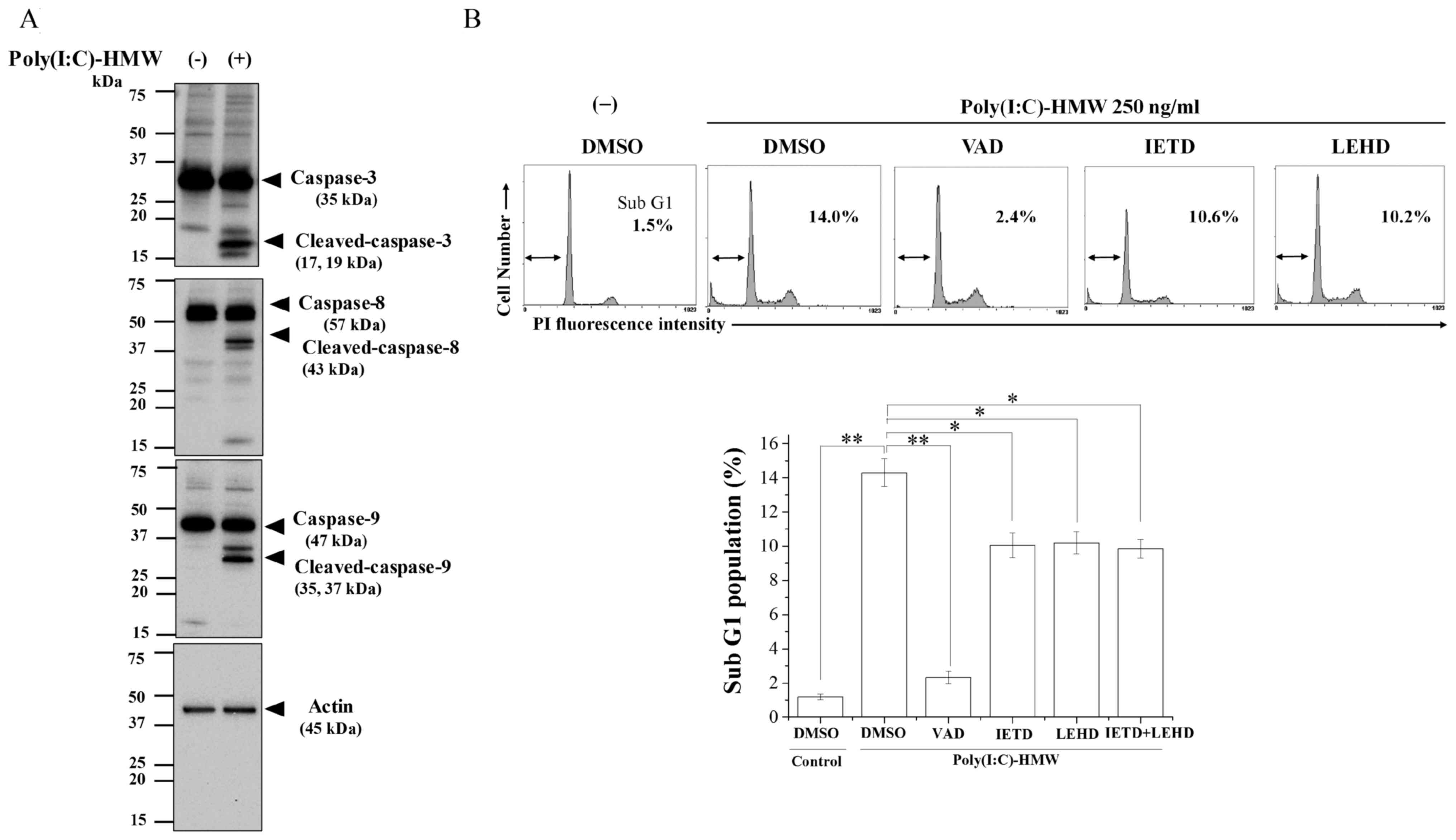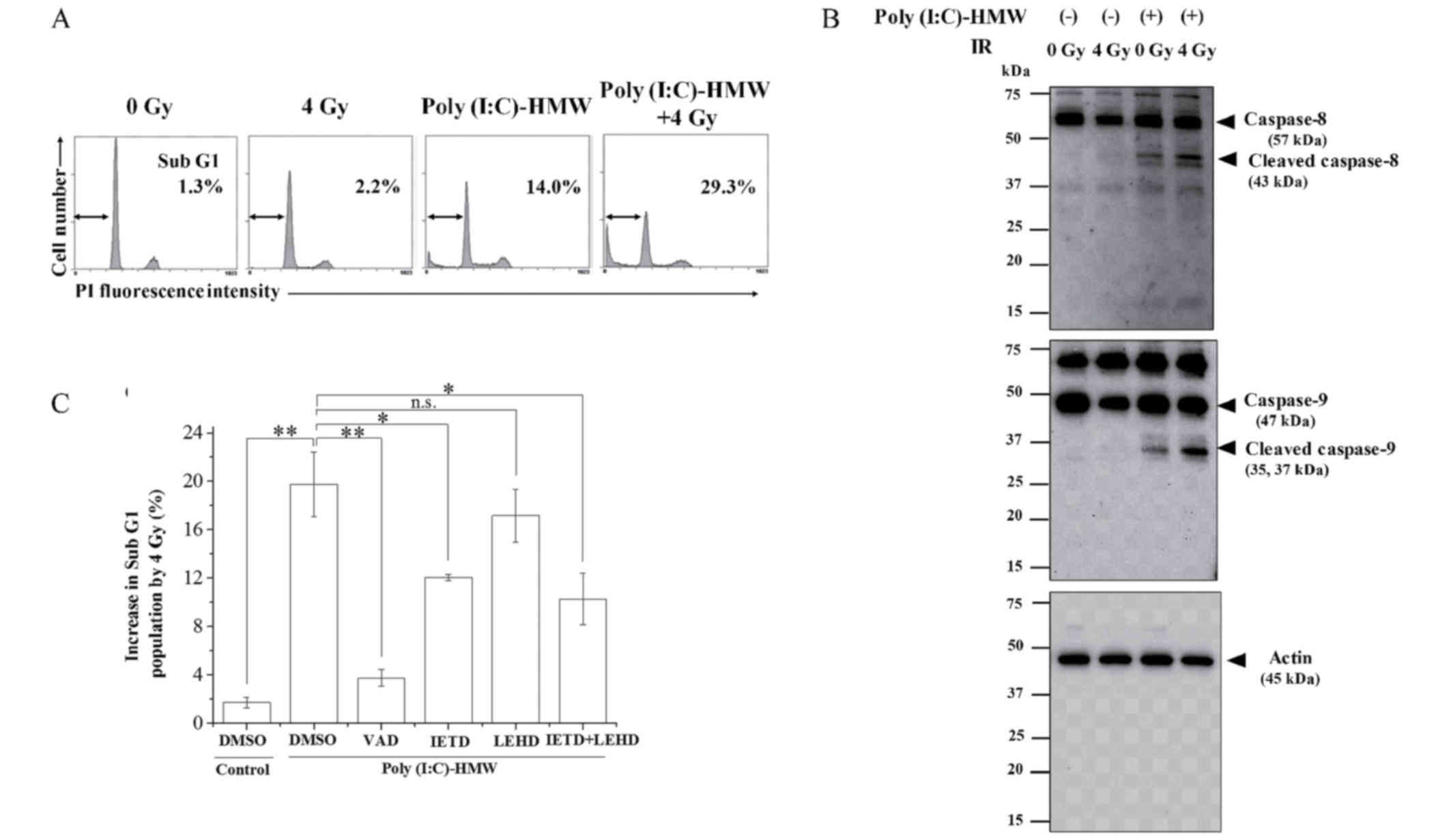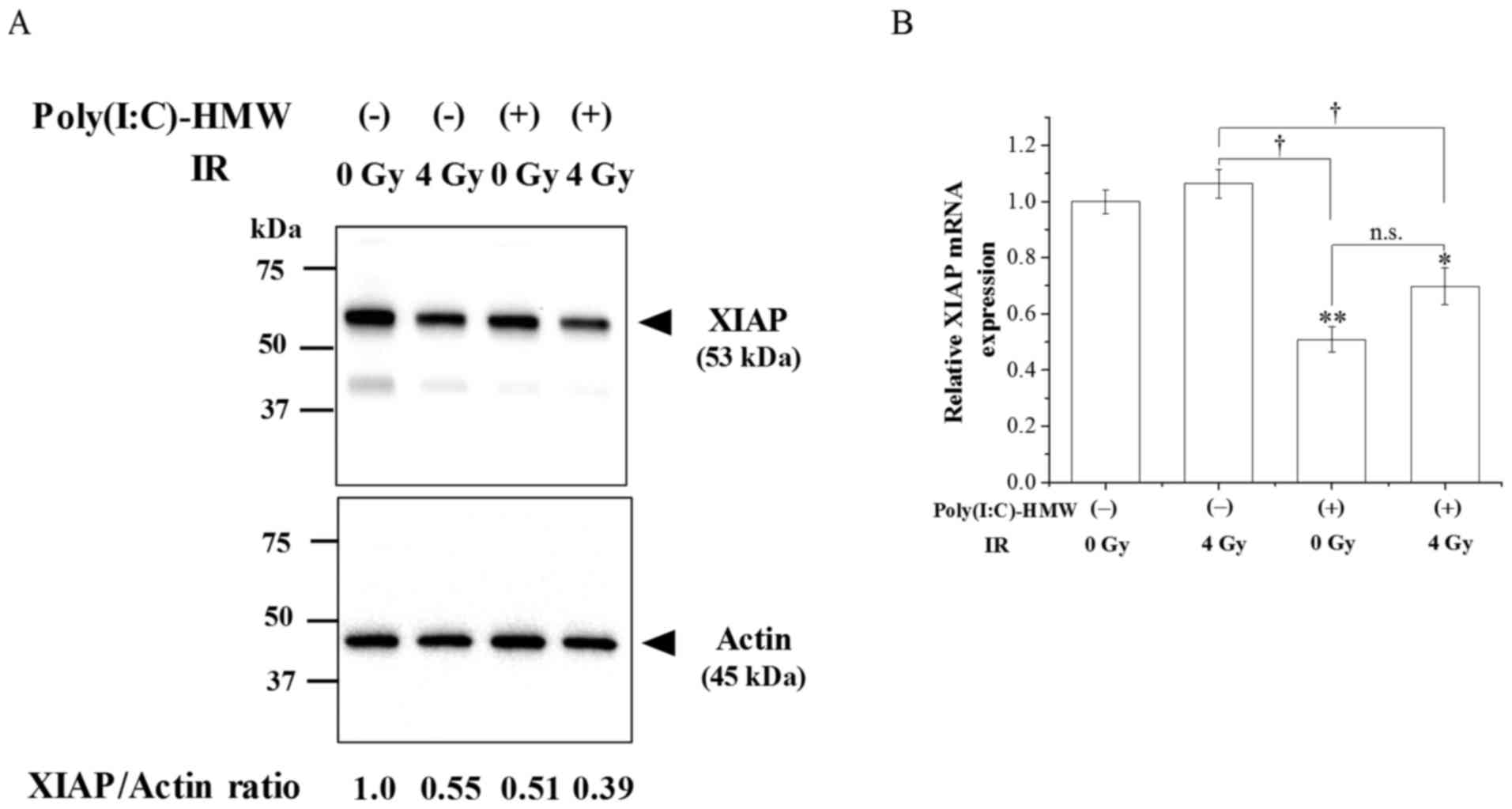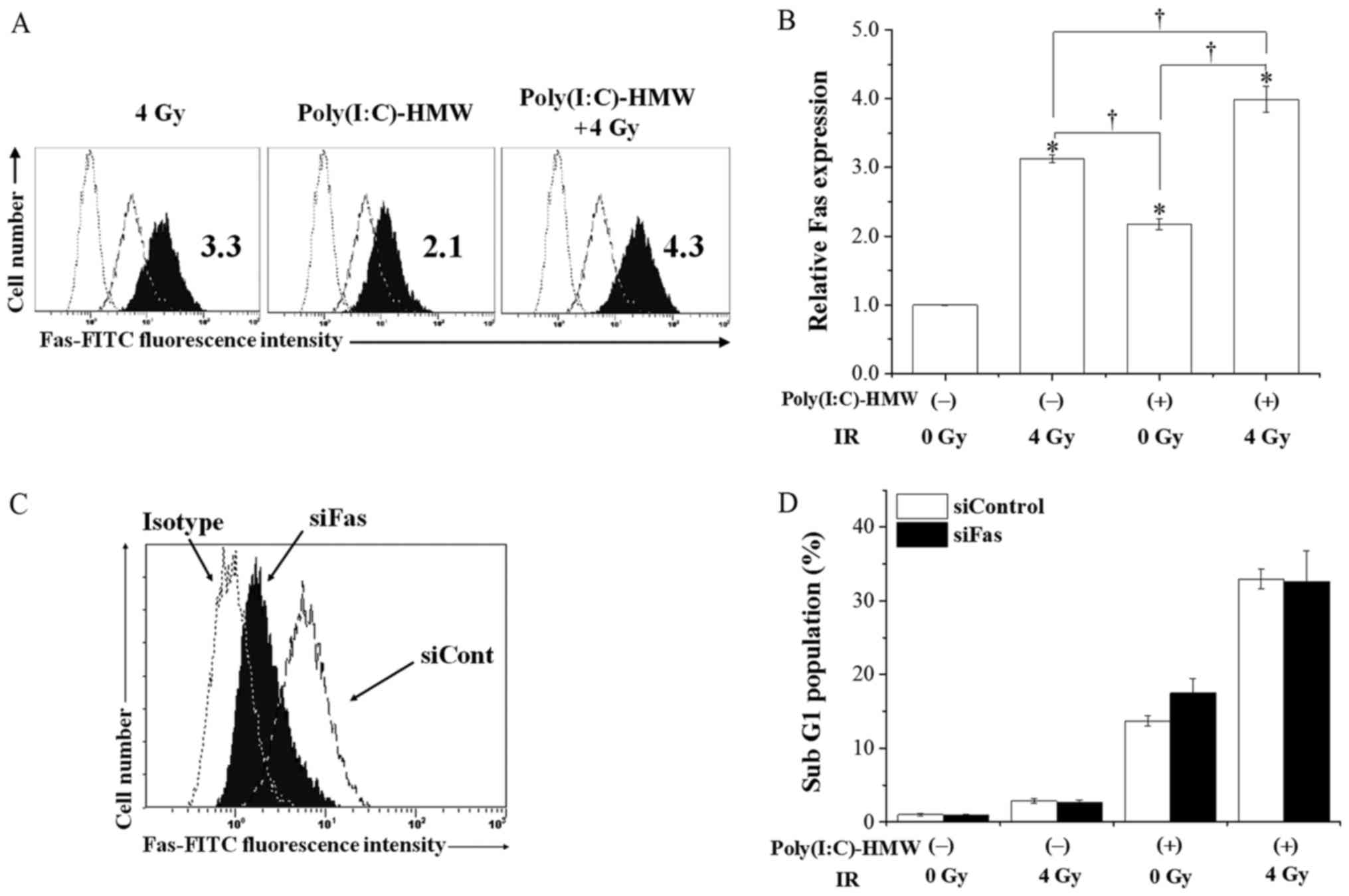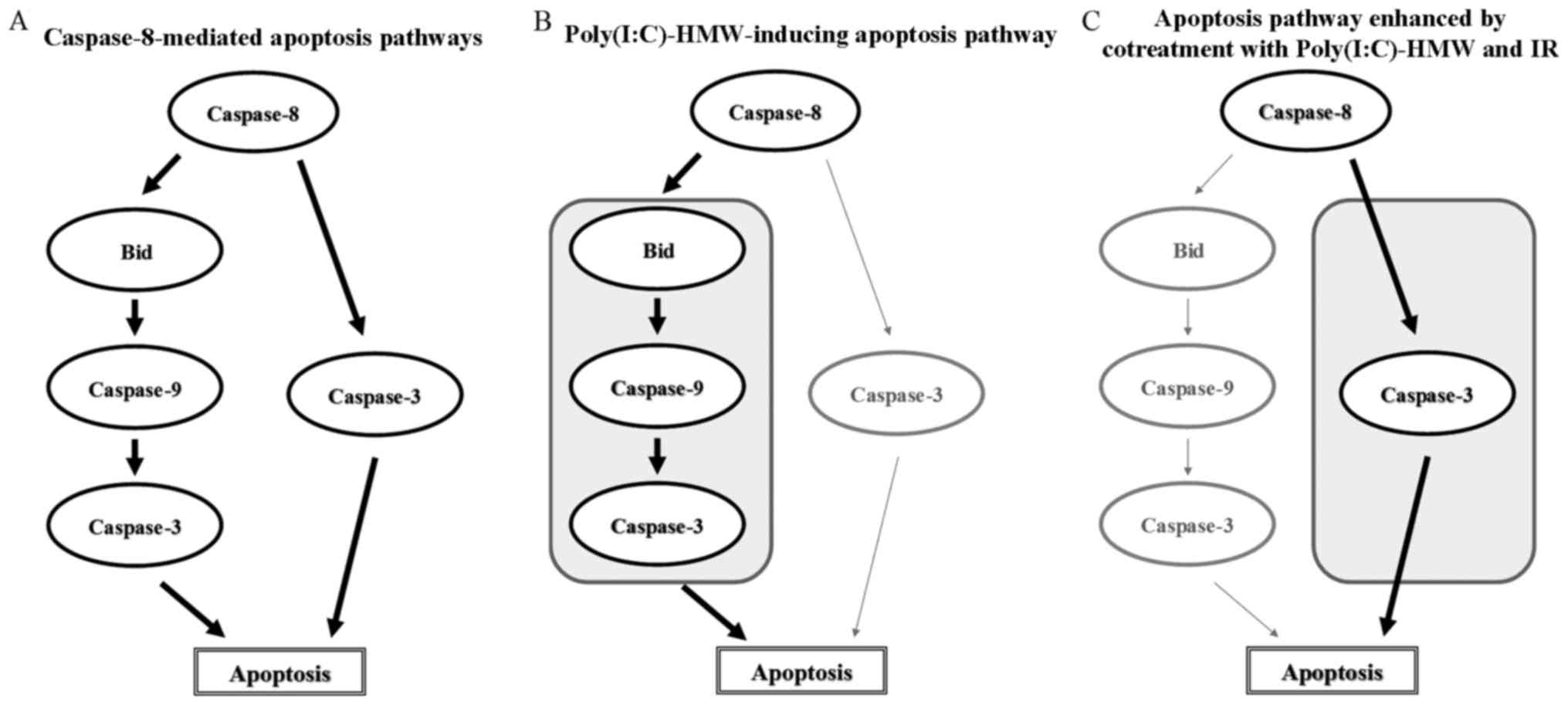|
1
|
Yoneyama M and Fujita T: Structural
mechanism of RNA recognition by the RIG-I-like receptors. Immunity.
29:178–181. 2008. View Article : Google Scholar : PubMed/NCBI
|
|
2
|
Kawai T, Takahashi K, Sato S, Coban C,
Kumar H, Kato H, Ishii KJ, Takeuchi O and Akira S: IPS-1, an
adaptor triggering RIG-I- and MDA5-mediated type I interferon
induction. Nat Immunol. 6:981–988. 2005. View Article : Google Scholar : PubMed/NCBI
|
|
3
|
Johnson CL and Gale M Jr: CARD games
between virus and host get a new player. Trends Immunol. 27:1–4.
2006. View Article : Google Scholar : PubMed/NCBI
|
|
4
|
Wu Y, Wu X, Wu L, Wang X and Liu Z: The
anticancer functions of RIG-I-like receptors, RIG-I and MDA5, and
their applications in cancer therapy. Transl Res. 190:51–60. 2017.
View Article : Google Scholar : PubMed/NCBI
|
|
5
|
Besch R, Poeck H, Hohenauer T, Senft D,
Häcker G, Berking C, Hornung V, Endres S, Ruzicka T, Rothenfusser S
and Hartmann G: Proapoptotic signaling induced by RIG-I and MDA-5
results in type I interferon-independent apoptosis in human
melanoma cells. J Clin Invest. 119:2399–2411. 2009.PubMed/NCBI
|
|
6
|
Yuan D, Xia M, Meng G, Xu C, Song Y and
Wei J: Anti-angiogenic efficacy of 5′-triphosphate siRNA combining
VEGF silencing and RIG-I activation in NSCLCs. Oncotarget.
6:29664–29674. 2015. View Article : Google Scholar : PubMed/NCBI
|
|
7
|
Poeck H, Besch R, Maihoefer C, Renn M,
Tormo D, Morskaya SS, Kirschnek S, Gaffal E, Landsberg J, Hellmuth
J, et al: 5′-Triphosphate-siRNA: Turning gene silencing and Rig-I
activation against melanoma. Nat Med. 14:1256–1263. 2008.
View Article : Google Scholar : PubMed/NCBI
|
|
8
|
Li D, Gale RP, Liu Y, Lei B, Wang Y, Diao
D and Zhang M: 5′-Triphosphate siRNA targeting MDR1 reverses
multi-drug resistance and activates RIG-I-induced
immune-stimulatory and apoptotic effects against human myeloid
leukaemia cells. Leuk Res. 58:23–30. 2017. View Article : Google Scholar : PubMed/NCBI
|
|
9
|
Yoshino H, Iwabuchi M, Kazama Y, Furukawa
M and Kashiwakura I: Effects of retinoic acid-inducible gene-I-like
receptors activations and ionizing radiation cotreatment on
cytotoxicity against human non-small cell lung cancer in
vitro. Oncol Lett. 15:4697–4705. 2018.PubMed/NCBI
|
|
10
|
Green DR and Llambi F: Cell death
signaling. Cold Spring Harb Perspect Biol. 7:pii: a006080. 2015.
View Article : Google Scholar : PubMed/NCBI
|
|
11
|
Rongvaux A: Innate immunity and tolerance
toward mitochondria. Mitochondrion. 41:14–20. 2018. View Article : Google Scholar : PubMed/NCBI
|
|
12
|
Mohamed MS, Bishr MK, Almutairi FM and Ali
AG: Inhibitors of apoptosis: Clinical implications in cancer.
Apoptosis. 22:1487–1509. 2017. View Article : Google Scholar : PubMed/NCBI
|
|
13
|
Takahashi K, Inanami O, Hayashi M and
Kuwabara M: Protein synthesis-dependent apoptotic signalling
pathway in X-irradiated MOLT-4 human leukaemia cell line. Int J
Radiat Biol. 78:115–124. 2002. View Article : Google Scholar : PubMed/NCBI
|
|
14
|
Kim MJ, Lee KH and Lee SJ: Ionizing
radiation utilizes c-Jun N-terminal kinase for amplification of
mitochondrial apoptotic cell death in human cervical cancer cells.
FEBS J. 275:2096–2108. 2008. View Article : Google Scholar : PubMed/NCBI
|
|
15
|
Yoshino H, Kumai Y and Kashiwakura I:
Effects of endoplasmic reticulum stress on apoptosis induction in
radioresistant macrophages. Mol Med Rep. 15:2867–2872. 2017.
View Article : Google Scholar : PubMed/NCBI
|
|
16
|
Wakasaya T, Yoshino H, Fukushi Y,
Yoshizawa A and Kashiwakura I: A liquid crystal-related compound
induces cell cycle arrest at the G2/M phase and apoptosis in the
A549 human non-small cell lung cancer cell line. Int J Oncol.
42:1205–1211. 2013. View Article : Google Scholar : PubMed/NCBI
|
|
17
|
Fukushi S, Yoshino H, Yoshizawa A and
Kashiwakura I: p53-independent structure-activity relationships of
3-ring mesogenic compounds' activity as cytotoxic effects against
human non-small cell lung cancer lines. BMC Cancer. 16:5212016.
View Article : Google Scholar : PubMed/NCBI
|
|
18
|
Yoshino H, Chiba K, Saitoh T and
Kashiwakura I: Ionizing radiation affects the expression of
Toll-like receptors 2 and 4 in human monocytic cells through c-Jun
N-terminal kinase activation. J Radiat Res. 55:876–884. 2014.
View Article : Google Scholar : PubMed/NCBI
|
|
19
|
Larionov A, Krause A and Miller W: A
standard curve based method for relative real time PCR data
processing. BMC Bioinformatics. 6:622005. View Article : Google Scholar : PubMed/NCBI
|
|
20
|
Yoshino H and Kashiwakura I: Involvement
of reactive oxygen species in ionizing radiation-induced
upregulation of cell surface toll-like receptor 2 and 4 expression
in human monocytic cells. J Radiat Res. 58:626–635. 2017.
View Article : Google Scholar : PubMed/NCBI
|
|
21
|
Darzynkiewicz Z, Buruno S, Del Bino G,
Gorczyca W, Hotz MA, Lassota P and Traganos F: Features of
apoptotic cells measured by flow cytometry. Cytometry. 13:795–808.
1992. View Article : Google Scholar : PubMed/NCBI
|
|
22
|
Yoshino H, Saitoh T, Kozakai M and
Kashiwakura I: Effects of ionizing radiation on retinoic
acid-inducible gene-I-like receptors. Biomed Rep. 3:59–62. 2015.
View Article : Google Scholar : PubMed/NCBI
|
|
23
|
El Maadidi S, Faletti L, Berg B, Wenzl C,
Wieland K, Chen ZJ, Maurer U and Borner C: A novel mitochondrial
MAVS/Caspase-8 platform links RNA virus-induced innate antiviral
signaling to Bax/Bak-independent apoptosis. J Immunol.
192:1171–1183. 2014. View Article : Google Scholar : PubMed/NCBI
|
|
24
|
Kalkavan H and Green DR: MOMP, cell
suicide as a BCL-2 family business. Cell Death Differ. 25:46–55.
2018. View Article : Google Scholar : PubMed/NCBI
|
|
25
|
Liu C, Sarkaria JN, Petell CA,
Paraskevakou G, Zollman PJ, Schroeder M, Carlson B, Decker PA, Wu
W, James CD, et al: Combination of measles virus virotherapy and
radiation therapy has synergistic activity in the treatment of
glioblastoma multiforme. Clin Cancer Res. 13:7155–7165. 2007.
View Article : Google Scholar : PubMed/NCBI
|
|
26
|
Porter AG and Jänicke RU: Emerging roles
of caspase-3 in apoptosis. Cell Death Differ. 6:99–104. 1999.
View Article : Google Scholar : PubMed/NCBI
|
|
27
|
Nakhaei P, Sun Q, Solis M, Mesplede T,
Bonneil E, Paz S, Lin R and Hiscott J: IκB kinase ε-dependent
phosphorylation and degradation of X-linked inhibitor of apoptosis
sensitizes cells to virus-induced apoptosis. J Virol. 86:726–737.
2012. View Article : Google Scholar : PubMed/NCBI
|
|
28
|
Cao C, Mu Y, Hallahan DE and Lu B: XIAP
and survivin as therapeutic targets for radiation sensitization in
preclinical models of lung cancer. Oncogene. 23:7047–7052. 2004.
View Article : Google Scholar : PubMed/NCBI
|
|
29
|
Eckelman BP, Salvesen GS and Scott FL:
Human inhibitor of apoptosis proteins: Why XIAP is the black sheep
of the family. EMBO Rep. 7:988–994. 2006. View Article : Google Scholar : PubMed/NCBI
|
|
30
|
Hiramatsu N, Messah C, Han J, LaVail MM,
Kaufman RJ and Lin JH: Translational and posttranslational
regulation of XIAP by eIF2α and ATF4 promotes ER stress-induced
cell death during the unfolded protein response. Mol Biol Cell.
25:1411–1420. 2014. View Article : Google Scholar : PubMed/NCBI
|
|
31
|
Galbán S and Duckett CS: XIAP as a
ubiquitin ligase in cellular signaling. Cell Death Differ. 7:54–60.
2010. View Article : Google Scholar
|
|
32
|
Yang Y, Fang S, Jensen JP, Weissman AM and
Ashwell JD: Ubiquitin protein ligase activity of IAPs and their
degradation in proteasomes in response to apoptotic stimuli.
Science. 288:874–877. 2000. View Article : Google Scholar : PubMed/NCBI
|
|
33
|
Afshar G, Jelluma N, Yang X, Basila D,
Arvold ND, Karlsson A, Yount GL, Dansen TB, Koller E and Haas-Kogan
DA: Radiation-induced caspase-8 mediates p53-independent apoptosis
in glioma cells. Cancer Res. 66:4223–4232. 2006. View Article : Google Scholar : PubMed/NCBI
|
|
34
|
Hamasu T, Inanami O, Asanuma T and
Kuwabara M: Enhanced induction of apoptosis by combined treatment
of human carcinoma cells with X rays and death receptor agonists. J
Radiat Res. 46:103–110. 2005. View Article : Google Scholar : PubMed/NCBI
|
|
35
|
Duewell P, Steger A, Lohr H, Bourhis H,
Hoelz H, Kirchleitner SV, Stieg MR, Grassmann S, Kobold S, Siveke
JT, et al: RIG-I-like helicases induce immunogenic cell death of
pancreatic cancer cells and sensitize tumors toward killing by
CD8(+) T cells. Cell Death Differ. 21:1825–1837. 2014. View Article : Google Scholar : PubMed/NCBI
|















